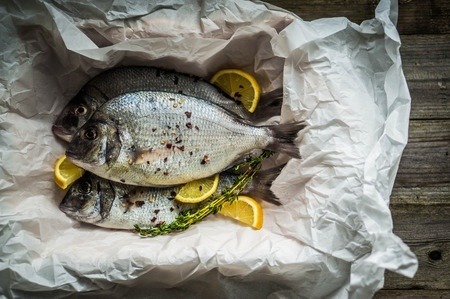
High pressure processing of fish would be a successful and commercial venture if it wasn’t for the rapid oxidative deterioration of the flesh that leads to rancidity and ruins the flavour (Ohshima, 2002).
Fish is a highly valuable nutritious food because of its high content of essential amino acids and polyunsaturated lipids. Unfortunately, fish can rapidly deteriorate without processing such as chilling, freezing or some other form of modifying treatment to inhibit protein and fat breakdown. The issue is generally lipid oxidation which produces the off-notes that reduce consumer appeal. Poor processing and storage leads to high wastage of fish and a drag on environmental resources designed to deal with products of high BOD (Biological Oxygen Demand).
It seems however that when the naturally derived antioxidants such as bixin and annatto which are the main carotenoids of annatto seeds are added there is a significant reduction in fat breakdown and the fish is more acceptable in sensory tests (Figueirêdo et al., 2015).
In the study, annatto and bixin were discovered to inhibit cholesterol oxidation when added to either minced herring (Clupea harengus) or minced mackerel (Scomber scombrus) during high pressure processing at 600 MPa for 10 min and subsequently chilled storage for 2 weeks. High pressure processing (HPP) has been found with a number of meat products to increase the rate and level of cholesterol oxidation products, often above a critical limit for human consumption.
In another aspect of the study, annatto rather than bixin reduced the loss of an important fatty acid, docosahexaenoic acid using HPP with herring. The loss was reduced from 12% to 7% when annatto was added. The effect was reasoned to be due to the antioxidative effects of the phenolic compounds in annatto, while bixin serves as a carotenoid and binds to membranes protecting membrane cholesterol.
Consumers are increasingly preferring to use natural antioxidants rather than artificial or synthetically derived types and plants provide a number in abundance. Annatto seed is commonly used to provide colour in savoury dishes. It has an 80% content of the carotenoid cis-bixin but also contains a number of polyphenols (Chisté et al., 2011; De Marco et al., 2013).
Annatto carotenoids are effective in vitro and in vivo scavengers of both reactive oxygen and nitrogen species (Kiokias and Gordon 2003; Chisté et al., 2011; Tsuruma et al., 2012).
Carotenoids have been found to be effective antioxidant in membranes through electron transfer to oxidizing radicals (Skibsted, 2012).The combination of added antioxidants and a non-thermal processing method such as high pressure processing will work more successfully with products susceptible to fat oxidation rather than each on its own.
References
Chisté, R.C., Mercadante, A.Z., Gomes, A., Fernandes, E., Lima, J.L.F.C., Bragagnolo, N. (2011) In vitro scavenging capacity of annatto seed extracts against reactive oxygen and nitrogen species. Food Chem. 127 pp. 419–26. (Article)
De Marco, R., Vieira, A.M.S., Ugrib, M.A., Monteiro, A., Bergamasco, R. (2013) Microencapsulation of annatto seed extract: stability and aplication. Chem. Eng. Trans. 32 pp. 1777–82.
Figueirêdo, B. C., Bragagnolo, N., Skibsted, L. H. and Orlien, V. (2015), Inhibition of Cholesterol and Polyunsaturated Fatty Acids Oxidation through the Use of Annatto and Bixin in High-Pressure Processed Fish. J. Food Science 80: C1646–C1653. doi: 10.1111/1750-3841.12964
Kiokias. S., Gordon, M.H. (2003) Antioxidant properties of annatto carotenoids. Food Chem. 83 pp. 523–29.
Ohshima, T. (2002) Formation and content of cholesterol oxidation products in seafood and seafood products. In: F. Guardiola, P. Dutta, R. Codony, G.P. Savage, editors. Cholesterol and phytosterol oxidation products in foods and biological samples: analysis, occurrence and biological effects. New York: AOAC Press. p. 187–03.
Skibsted, L.H. (2012) Carotenoids in antioxidant networks. Colorants or radical scavengers. J. Agric. Food Chem. 60 pp. 2409–17.
Tsuruma, K., Shimazaki, H., Nakashima, K., Yamauchi, M., Sugitani, S., Shimazawa, M., Hara, H. (2012) Annatto prevents retinal degeneration induced by endoplasmic reticulum stress in vitro and in vivo. Mol. Nutr. Food Res. 56 pp. 713–24.
Really interesting – write more as I’m doing an essay on this type of processing !
Hi Alice,
High pressure processing is certainly a novel technology becoming part of the mainstream of the moment. Have a look at the Australian milk producer using high pressure as a good commercial example but don’t forget other novel processing like ohmic heating, pulsed electric field, ultrasound etc. Send me a version once it’s marked and I’ll put on this web-site.
Its me again – Bob. Really interested in this process because I can see it cooking a whole load of foods which I like. Ay chance you can find me a kitchen sized high pressure processing piece of kit for use in the home ?